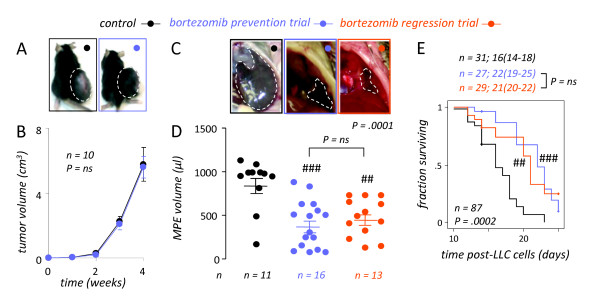Figure 3.
NF-κB-targeted bortezomib treatment specifically inhibits MPE but not subcutaneous tumor formation by lung adenocarcinoma. (A, B) NF-κB-targeted bortezomib treatment has no effect on subcutaneous Lewis lung carcinoma (LLC) growth. C57BL/6 mice received 5 × 105 subcutaneous LLC cells followed by bi-weekly intraperitoneal bortezomib (100 ng/g = 0.1 mg/kg) or PBS. Separate subsets of mice received treatment either immediately (prevention trial) or starting one week after tumor implant (regression trial). Tumor volume was determined weekly and mice were sacrificed on day 28. Representative images at 4 weeks (A; dashed lines outline tumors) and mean volume (B) of subcutaneous tumors in PBS and bortezomib treated mice. Results from prevention and regression trial were identical and were grouped for demonstration purposes. Dots, mean; bars, standard error of mean. (C-E) NF-κB-targeted bortezomib treatment is effective against malignant pleural effusion (MPE) induced by LLC cells. C57BL/6 mice received 1.5 × 105 intrapleural LLC cells followed by bi-weekly bortezomib (100 ng/g = 0.1 mg/kg) or PBS. Mice were enrolled in prevention (immediate treatment) or regression (treatment starting after one week) trials and were sacrificed on day 14 (C, D) or observed till moribund (E). (C) Representative transdiaphragmatic photographs at 14 days (dashed lines outline MPEs) and (D) mean volume of MPE in PBS- and bortezomib-treated mice. Dots, raw data points; lines, mean; bars, SEM. (E) Survival of MPE-bearing mice treated with PBS or bortezomib. Shown are Kaplan-Meier survival curves and estimates (median, 95% confidence interval) of pooled data from three independent experiments. (D, E) Note that results from prevention and regression trials were not significantly different (ns). n, sample size; P, probability values. ## and ###: P < .01 and .001, respectively, compared with control.

